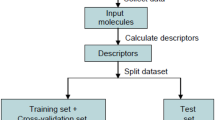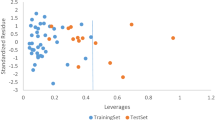Abstract
Endocrine disrupting chemicals (EDCs) in the natural environment exhibit a unique non-monotonic dose-response curve and it is impossible to select one simple index to characterize the bilogogical activity of these compounds. Quantitative structure-activity relationship (QSAR) study on non-monotonic dose-response curve has become a real challenge presently. In order to explore the possible mechanism for the non-monotonic dose-response curve of polychlorinated biphenyls congeners (PCBs) in chicken embryo hepatocyte bioassay, AM1 method of ChemOffice was adopted to calculate necessary structure descriptors for PCBs, while the interactions between PCBs and simulated AhR ligand binding domain (LBD) were analyzed by using FlexX in SYBYL7.0. Different binding modes for PCBs have been distinguished not only from aligned conformation but also from free binding energy. Some QSAR models were established separately for both low and high doses ranges, revealing that receptor binding may predominate in the interference of the physiological function of cytochrome P4501A-P4501A in the low doses range. But with the higher doses range, the EROD suppression might be related to acute toxicity owing to molecular polarity or distribution of charges and consequently damage structure and function of chicken embryo hepatocyte.
Similar content being viewed by others
References
Saal F S, Timms B G, Montano M M, Palanza P, Thayer K A, Nagel S C, Dhar M D, Ganjam V K, Parmigiani S, Welshons W S. Prostate enlargement in mice due to fetal exposure to low doses of estradiol or diethylstilbestrol and opposite effects at high doses. Proc Natl Acad Sci USA, 1997, 94: 2056–2061
Wetherill Y B, Petre C E, Monk K R, Puga A, Knudsen K E. The xenoestrogen bisphenol A induces inappropriate androgen receptor activation and mitogenesis in prostatic adenocarcinoma cells. Mol Cancer Ther, 2002, 1: 515–524
Saal F S, Nagel S C, Palanza P, Boechler M, Parmigiani S, Welshons W S. Estrogenic pesticides: Binding relative to estradiol in MCF-7 cells and effects of exposure during fetal life on subsequent territorial behaviour in male mice. Toxicol Lett, 1995, 77: 343–350
Zala S M, Penn D J. Abnormal behaviours induced by chemical pollution: A review of the evidence and new challenges. Anim Behav, 2004, 68: 649–664
Miao X S, Chu S G, Xu X B. Advances in the research of structure-activity relation ships for polychlorinated biphenyls. Prog Chem (in Chinese), 1996, 8(4): 293–300
Welshons W V, Thayer K A, Judy B M, Taylor J A, Curran E M, Saal F S. Large effects from small exposures. I. Mechanisms for endocrine-disrupting chemicals with estrogenic activity. Environ Health Perspect, 2003, 111(8): 994–1006
Kennedy S W, Lorenzen A, Norstrom R J. Chicken embryo hepatocyte bioasay for measuring cytochrome P4501A-based 2,3,7,8-tetrachloro dibenzopdioxin equivalent concentrations in environmental samples. Environ Sci Technol, 1996, 30: 706–715
Safe S, Bandiera S, Sawyer T, Zmudzka B, Mason G, Romkes M. Effects of structure on binding to the 2,3,7,8-TCDD receptor protein and AHH induction—Halogenated biphenyls. Environ Health Perspect, 1985, 61: 21–23
Safe S. Polychlorinated biphenyls (PCBs), dibenzo-p-dioxins (PCDDs), dibenzofurans (PCDFs), and related compounds: Environmental and mechanistic considerations which support the development of toxic equivalency factors (TEFs). Crit Rev Toxicol, 1990, 21: 51–88
Bandiera S, Sawyer T W, Campbell M A, Fujita T, Safe S. Competitive binding to the cytosolic 2,3,7,8-tetrachlorodibenzo-p-dioxin receptor: effects of structure on the affinities of substituted halogenated biphenyls — A QSAR analysis. Biochem Pharmacol, 1983, 32: 3803–3813
Bandiera S, Safe S, Okey A B. Binding of polychlorinated biphenyls clasified as either phenobarbitone-, 3-methylchlolanthrene- or mixed-type inducers to cytosolic Ah receptor. Chem Biol Interact, 1982, 39: 259–277
White R, Jobling S, Hoare S A, Sumpter J P, Parker M G. Environmentally persistent alkyl-phenolic compounds are estrogenic. Endocrinology, 1994, 135(1): 175–182
Shipley J M, Waxman D J. Aryl hydrocarbon receptor-independent activation of estrogen receptor-dependent transcription by 3-methycholanthrene. Toxicol Appl Pharmacol, 2006, 213(2): 87–97
Denison M S, Pandini A, Nagy S R, Baldwin E P, Bonati L. Ligand binding and activation of the Ah receptor. Chem Biol Interact, 2002, 141: 3–24
Procopiol M, Lahm A, Tramontano A, Bonati1 L, Pitea1 D. A model for recognition of polychlorinated dibenzo-p-dioxinsby the aryl hydrocarbon receptor. Eur J Biochem, 2002, 269: 13–18
Gillner M, Bergman J, Cambillau C, Fernstrom B, Gustafson J R. Interactions of indols with specific binding sites for 2,3,7,8-tetrachlorodibenzo-p-dioxin in rat liver. Mol Pharmaco, 1985, 28: 357–363
Waller C L, McKinney J D. Three-dimensional quantitative structure-activity relationships of dioxins and dioxin-like compounds: Model validation and Ah receptor characterization. Chem Res Toxicol, 1995, 8: 847–858
Santostefano M, Liu H, Wang X H, Chaloupka K, Safe S. Effect of ligand structure on formation and DNA binding properties of the transformed rat cytosolic arylhydrocarbon receptor. Chem Res Toxicol, 1994, 7: 544–550
Edwards P R, Hrycay E G, Bandiera S M. Differential inhibition of hepatic microsomal alkoxyresorufin O-dealkylation activities by tetrachlorobiphenyls. Chem Biol Interact, 2007, 169(1): 42–52
Shoji H, Tomoko I, Totaro Imasaka. Chlorine substitution pattern, molecular electronic properties, and the nature of the ligand-receptor interaction: Quantitative property-activity relationships of polychlorinated dibenzofurans. Chem Res Toxicol, 2005, 18: 232–238
Hahn M E, Lamb T M, Schultz M E, Smolowitz R M, Stegeman J J. Cytochrome P4501A induction and inhibition by 3,3′,4,4′-tetrachlorobiphenyl in an Ah receptor-containing fish hepatoma cell line (PLHC-1). Aquatic Toxicology, 1993, 26(3–4): 185–208
Head J A, Kennedy S W. Differential expresion, induction, and stability of CYP1A4 and CYP1A5 mRNA in chicken and herring gull embryo hepatocytes. Comp Biochem Phys C, 2007, 145: 617–624
Author information
Authors and Affiliations
Corresponding author
Additional information
Supported by the National Natural Science Foundation of China (Grant Nos. 20777035 & 20737001) and 863 Advanced Research Project (Grant Nos. 2007AA06Z416, 2006AA06Z424 & 2007AA06A405)
Rights and permissions
About this article
Cite this article
Mu, Y., Zhang, A., Gao, C. et al. QSAR study on the non-monotonic dose-response curve of PCBs in chicken embryo hepatocyte bioassay. Sci. China Ser. B-Chem. 52, 662–669 (2009). https://doi.org/10.1007/s11426-009-0023-1
Received:
Accepted:
Published:
Issue Date:
DOI: https://doi.org/10.1007/s11426-009-0023-1




